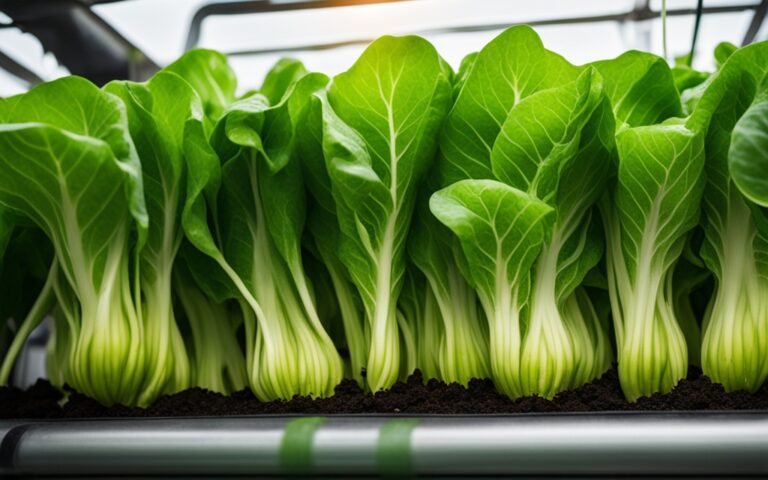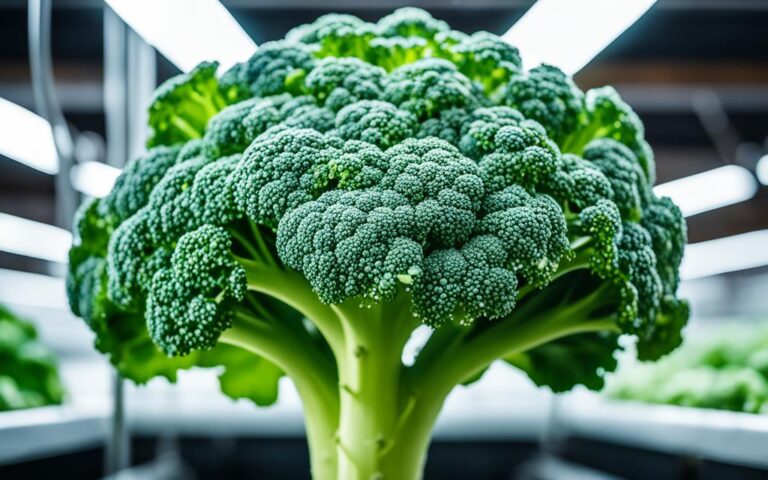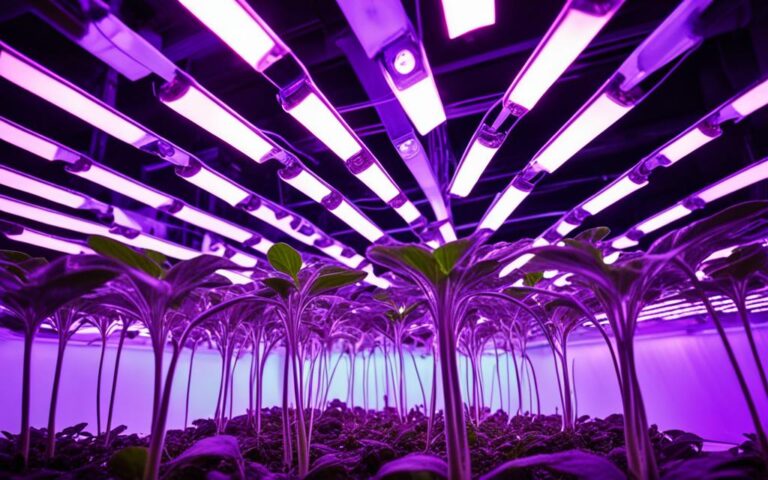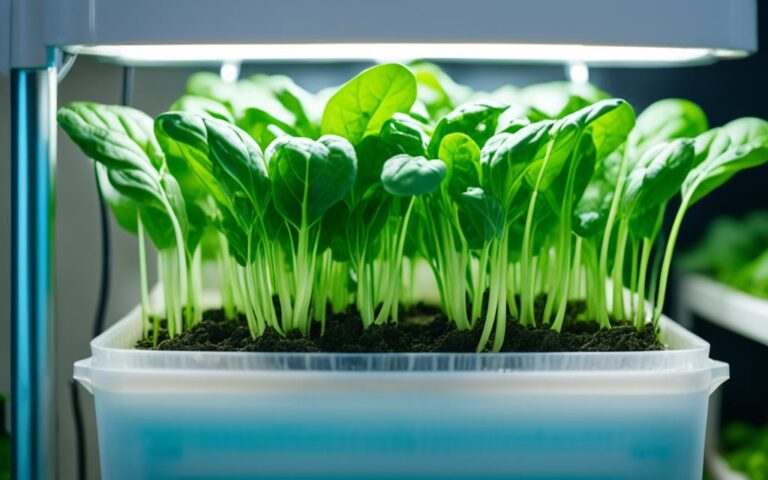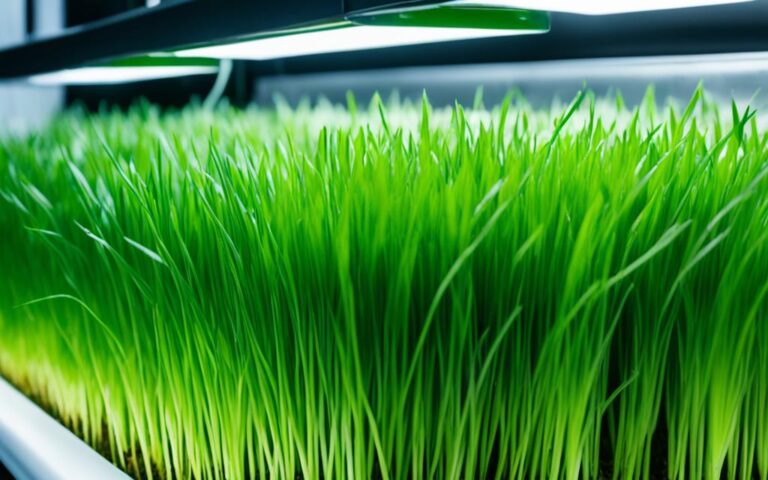Growing Hydroponic Squash: Tips & Techniques
Did you know the global hydroponic market is set to hit $45 billion by 2026? This growth is thanks to the demand for fresh, local produce and the boom in urban farming. Squash is a top choice for hydroponics, being both versatile and nutritious. This guide is perfect for both new and experienced hydroponic gardeners. It offers all the tips and techniques you need to grow hydroponic squash successfully.
Key Takeaways
- Hydroponic squash cultivation offers a solution to the challenges of outdoor growing, allowing for greater control over the growing environment.
- Selecting the right hydroponic system, such as Dutch Buckets or Deep Water Culture, is crucial for optimal squash growth.
- Proper nutrient management, including maintaining optimal pH and EC/TDS levels, is essential for healthy squash plants.
- Providing the right amount of light, both in terms of intensity and duration, is key for achieving bountiful harvests.
- Careful attention to temperature, airflow, and plant training can significantly improve hydroponic squash yields.
Table of Contents
The Best Hydroponic Systems for Growing Squash
When growing squash with hydroponics, some systems stand out. The best hydroponic system for squash depends on the plant’s needs and space. Two systems are clear winners.
Dutch Buckets or Bato Buckets
Dutch buckets, also known as Bato buckets, are a top pick for growing squash hydroponically. They support the plant’s big roots well. This is key for squash plants that spread out a lot.
The system has an expanded clay pebble base and perlite medium. These provide great drainage and air for the roots. This helps the roots grow strong.
Deep Water Culture (DWC) Systems
The Deep Water Culture (DWC) system is another great choice for hydroponic squash cultivation. In a DWC setup, the roots hang in nutrient-rich water. This helps the plants grow fast and strong.
This system works well with dutch buckets for squash and DWC for squash. It gives plants a stable, controlled place to grow.
Both Dutch/Bato buckets and DWC systems work well for hydroponic squash. They give the plants the support, air, and nutrients they need. Think about your space, budget, and what you like to choose the best hydroponic system for squash for you.
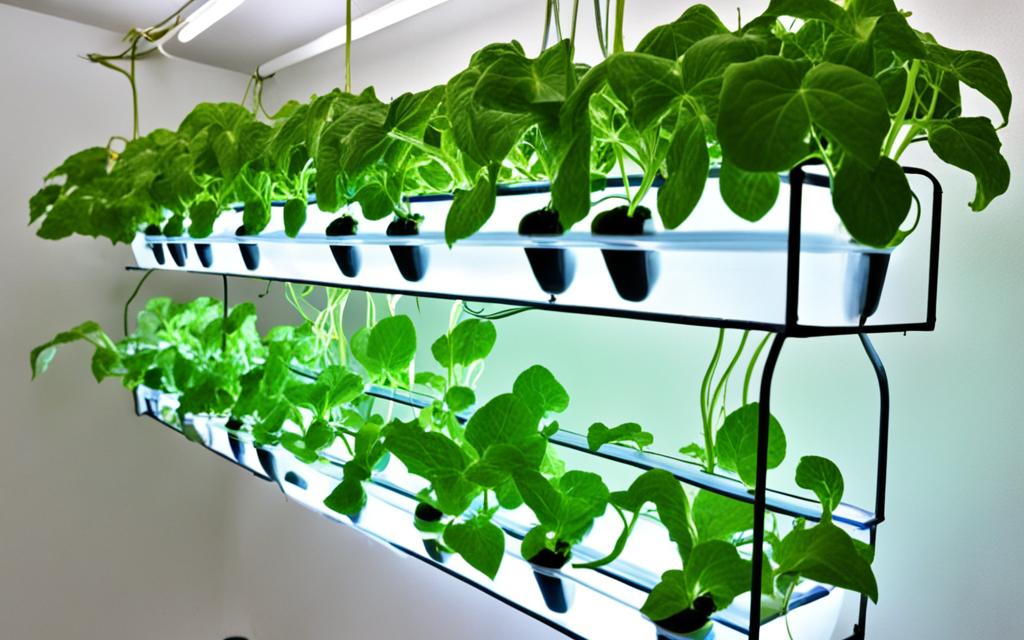
Selecting and Starting Squash Plants
Growing hydroponic squash can be done from seeds or by using transplants. Each method has its benefits, depending on your garden setup and needs.
Growing from Seeds vs. Transplants
Starting squash from seed is both rewarding and budget-friendly. Squash and zucchini seeds germinate quickly, taking 3 to 15 days. This method lets you control the growing process and tailor your plants to your hydroponic setup.
On the other hand, buying pre-grown hydroponic squash transplants is a quick option. It saves time by skipping the seed-starting phase. Transplants grow faster in hydroponics, leading to a quicker harvest.
Ideal Germination Temperature and Environment
Whether starting with seeds or transplants, the right temperature is key for germination. Aim for a temperature between 70°F and 75°F, with 72°F ideal. A warm, steady environment helps seeds sprout and grow well.
Many growers use starter plugs like Rapid Rooter for germinating squash seeds. These plugs offer the right mix of moisture, air, and support for young seedlings to develop strong roots.
Nutrient Management for Hydroponic Squash
Keeping the right balance of nutrients is key for hydroponic squash to grow well. These plants need different nutrients at different stages, from the vegetative to the flowering stage. Knowing what nutrients they need at each stage helps them grow strong.
Essential Nutrients for Vegetative and Flowering Stages
In the early stages, hydroponic squash nutrients focus on nitrogen. This helps the plant grow strong leaves and roots. When the plant starts to flower and produce fruit, the nutrient mix changes. It gets more phosphorus and potassium. These are vital for flowers and fruits to grow well.
Many top hydroponic growers use the Flora Series from General Hydroponics. This system lets them adjust the squash nutrient requirements as the plant grows. It helps ensure the best growth and harvests.
Maintaining Optimal pH and EC/TDS Levels
It’s also important to keep the right hydroponic squash pH and EC or TDS levels. The best pH for hydroponic squash is about 6.0, which helps the plant absorb nutrients well. The EC or TDS should be between 1.8 to 2.4 mS. This range provides the right amount of hydroponic squash nutrients without causing harm.
By watching and adjusting the nutrient solution’s pH and EC/TDS, growers can make the perfect environment for their squash. This helps the plants grow well.
Light Requirements for Hydroponic Squash
Squash grows fast and produces a lot, so it needs a lot of light. To grow well, it should get about 25 to 30 units of light every day. This is key for its growth and fruiting.
Daily Light Integral (DLI) Needs
The DLI measures how much light a plant gets in a day. It’s important for the plant’s health and how much it produces. Squash does best with a steady amount of light in this range.
Types of Grow Lights for Squash
For the hydroponic squash light requirements, there are many grow lights to choose from. The ViparSpectra grow light is a good choice because it gives the right amount of light. These lights should be on for 14 to 18 hours and off for 6 to 10 hours. This changes as the plant grows from the vegetative to the flowering and fruiting stages.
| Light Requirement | Optimal Range |
|---|---|
| Daily Light Integral (DLI) | 25 to 30 mol/m²/day |
| Lighting Duration | 14 to 18 hours on, 6 to 10 hours off |
Using the right grow lights for hydroponic squash helps the plant grow fast and produce a lot of fruit.
hydroponic Squash
Growing squash hydroponically is exciting for gardeners and small farmers. This vegetable does well in a hydroponic setup, letting growers control the environment. It’s great for those new to hydroponics or experienced growers. The secret to successful hydroponic squash is knowing what this plant needs.
One big plus of squash hydroponics is controlling the nutrients. Growers can make sure their squash gets exactly what it needs, when it needs it. This means the plants grow strong and produce a lot.
Maximizing Hydroponic Squash Yields
To get the most from your hydroponic squash, try these tips:
- Optimizing light exposure: Squash needs a lot of good light. Make sure they get enough daily light integral (DLI) for growth and fruit.
- Maintaining optimal temperature and airflow: Keep the temperature right and air moving well around the plants. This helps them stay healthy and productive.
- Implementing efficient training and pruning techniques: Prune and train the plant to focus energy on growing big, tasty squash.
With practice in hydroponic squash growing, you can enjoy a lot of fresh, tasty squash.
Temperature and Airflow Needs
For hydroponic squash to grow well, it needs the right temperature and airflow. These plants do best in warm weather, between 60°F and 85°F. This range is perfect for their growth and how much they produce.
Ideal Temperature Range
Experts say the best temperature for hydroponic squash is 72°F to 77°F. This temperature helps the plants grow strong, with healthy leaves, roots, and lots of fruit.
Importance of Air Circulation
Good air movement is as important as the right temperature for squash. It stops humidity from building up, which can cause mold. It also helps the plants use nutrients better, making them grow and produce more.
To keep the air moving, growers use small fans. These fans create a soft breeze that moves the squash leaves and stems. This simple step greatly improves the squash’s health and yield.
“Maintaining the ideal temperature and airflow is crucial for the successful cultivation of hydroponic squash. By providing the right growing conditions, growers can maximize the plants’ potential and enjoy bountiful harvests.”
Pruning and Training Hydroponic Squash Plants
Growing hydroponic squash needs careful pruning and training. These steps help keep the plant healthy and productive. They control the plant’s size, improve air flow, and focus energy on making more fruit.
Start by pruning off the lower leaves once the first fruit is picked. As the plant gets taller, keep removing lower leaves. This keeps air moving and light getting through. It also makes the plant look better and grow stronger.
Training hydroponic squash plants is also key. Use trellises, cages, or other supports to guide the plant. This keeps the vines off the ground and makes harvesting easy. Regular training keeps the plant tidy and productive.
By using pruning and training techniques, growers can make the most of their hydroponic squash. These methods take time and effort but are worth it for better plant health, air flow, and more fruit.
Hand Pollination Techniques
Hand pollination is key for growing hydroponic squash. These plants don’t pollinate themselves. They need pollen from male to female flowers to set fruit. To pollinate your squash, first identify the male and female flowers. Then, use a simple tool to move the pollen.
Identifying Male and Female Flowers
Squash plants have both male and female flowers. It’s crucial to know the difference. Male flowers have long, thin stalks and bloom first. Female flowers have a small fruit at their base.
Proper Pollination Methods
After finding the flowers, use a tool like a cotton swab or paintbrush for pollination. Touch the pollen-covered anthers of the male flower to the female flower’s stigma. This ensures the pollen moves over. Do this for each female flower to boost fruit set chances.
Regular hand pollination is vital for a good squash harvest. Knowing the male and female flowers and how to pollinate them helps your squash plants thrive. This way, you’ll get lots of delicious fruits.
Common Pests and Diseases in Hydroponic Squash
Growing squash hydroponically helps avoid some pest and disease problems. But, you still need to watch out for issues. Keeping an eye on your plants and acting fast is key to keeping them healthy and productive.
Identifying and Preventing Pests
Pests like aphids, spider mites, and powdery mildew can hit hydroponic squash. Check your plants often and act quickly to stop problems from getting worse. Here are some ways to prevent pests in hydroponic squash:
- Use a strong integrated pest management (IPM) program
- Add beneficial insects or biological controls
- Keep growing conditions just right to avoid pests
- Clean and sanitize your hydroponic setup regularly
Recognizing and Treating Diseases
Hydroponic systems can cut down on some diseases, but hydroponic squash can still face issues like nutrient shortages, root rot, and fungal diseases. It’s important to know how to identify and treat diseases in hydroponic squash. Watch for signs like:
- Yellow or discolored leaves
- Stunted growth or wilting
- Unusual spots, lesions, or mold on the plant
Fixing these issues quickly can mean making changes to the nutrient solution, environment, or using approved medicines. This can help fix diseases in hydroponic squash and get your plants healthy again.
Harvesting Hydroponic Squash
Knowing the best time to pick your hydroponic squash is key for a great harvest. The main thing to watch for is the size and look of the squash.
Determining When to Harvest
Summer squash like zucchini and yellow squash are ready when they’re 6 to 9 inches long and have soft skin. If you wait too long, they’ll get big, full of seeds, and watery. Keep an eye on your plants and pick them when they’re just right.
Proper Harvesting Techniques
To harvest hydroponic squash, use sharp shears or scissors to cut the stem just above the squash. Don’t try to tear it off, as it can hurt the plant. Handle the squash carefully because they’re delicate and can easily get damaged.
After picking, you can store hydroponic squash in the fridge for up to a week. This keeps them fresh and tasty until you’re ready to use them in your favorite dishes.
“Proper timing and technique are key for a successful hydroponic squash harvest. Paying attention to the size and appearance of the fruits will ensure you get the best possible yield.”
By following these tips for when to harvest hydroponic squash and how to harvest hydroponic squash, you can get the most out of your squash plants. Enjoy delicious, fresh squash all season long.
Troubleshooting Nutrient Deficiencies
Keeping the right balance of nutrients is key for hydroponic squash plants to stay healthy and productive. By watching the plants closely and fixing any nutrient imbalances, growers can help their squash thrive.
Identifying Deficiency Symptoms
Spotting the signs of nutrient shortages in hydroponic squash is the first step to fixing the problem. Look out for these common signs:
- Stunted growth or delayed maturity
- Discoloration of leaves, such as yellowing, browning or spotting
- Poor fruit production or smaller-than-expected yields
- Leaf curling, wilting or other signs of stress
Correcting Nutrient Imbalances
After finding a nutrient shortage, growers can fix it to keep their hydroponic squash plants healthy. This might mean tweaking the nutrient solution’s pH, adding certain nutrients, or cleaning the system to get rid of excess salts or minerals.
| Common Nutrient Deficiencies in Hydroponic Squash | Symptoms | Corrective Measures |
|---|---|---|
| Nitrogen (N) Deficiency | Yellowing of older leaves, stunted growth | Increase nitrogen levels in the nutrient solution |
| Phosphorus (P) Deficiency | Purplish discoloration of leaves, delayed maturity | Increase phosphorus levels in the nutrient solution |
| Potassium (K) Deficiency | Leaf edges turning yellow or brown, reduced fruit production | Increase potassium levels in the nutrient solution |
By keeping a close eye on their hydroponic squash and adjusting the nutrients as needed, growers can keep their crops healthy and productive all season.
Tips for Maximizing Hydroponic Squash Yields
To get a lot of hydroponic squash, you need a good plan. Using a few key methods can help you get more squash from your plants. Here are some tips to increase your hydroponic squash production.
Choosing the right squash type is very important. Pick ones that grow well in small spaces and produce a lot. This helps use your growing area well and increases your harvest.
Keeping the right conditions for your squash is key. Make sure the temperature, light, and air flow are just right. These things affect how well your plants grow, flower, and produce squash.
- Provide the ideal temperature between 70-85°F (21-29°C) for optimal growth.
- Ensure your plants receive sufficient light, aiming for a daily light integral (DLI) of 18-24 mol/m²/day.
- Implement effective air circulation to promote healthy plant development and prevent disease issues.
Managing nutrients well is also crucial. Keep an eye on the pH and EC or TDS levels in your system. This makes sure your squash gets the nutrients it needs to grow well.
Don’t forget about pruning and pollinating your squash. Pruning helps the plant focus on growing bigger squash. Pollinating by hand can also help more squash grow.
Using these tips in your squash growing can really help your plants. You’ll get a lot of squash every season.
Conclusion
Hydroponic squash growing is a great way to garden indoors. It lets gardeners control the growing conditions for better harvests. This guide has shown how to pick the right hydroponic system and manage nutrients and the environment.
It also covered how to handle lighting, temperature, and pollination. With this knowledge, you can grow tasty and plenty of hydroponic squash. You’ll know how to spot and fix pests, diseases, and nutrient issues.
Whether you’re experienced or new to hydroponic gardening, this article has useful tips. It helps you make the most of growing hydroponic squash and hydroponic squash cultivation at home. Start your hydroponic gardening journey for more harvests and tasty squash.

